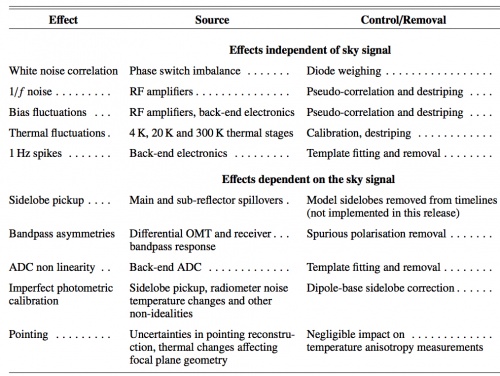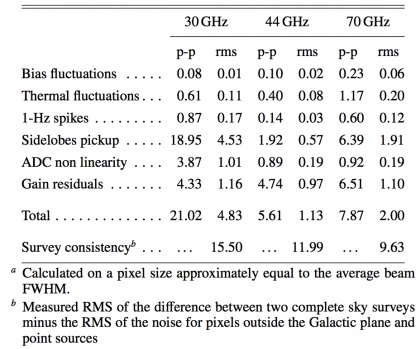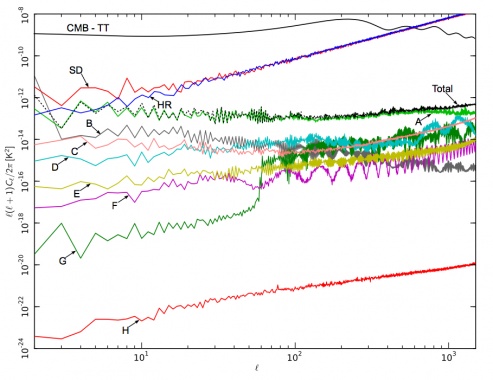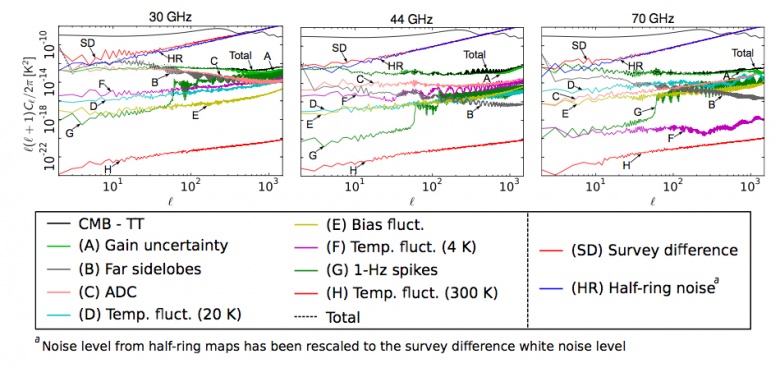Systematic effect uncertainties
Contents
[hide]Overview[edit]
Known systematic effects in the Planck-LFI data can be divided into two broad categories: effects independent of the sky signal, which can be considered as additive or multiplicative spurious contributions to the measured timelines, and effects which are dependent on the sky and that cannot be considered independently from the observation strategy.
Here we report a brief summary of these effects, all the details can be found inPlanck-2013-III[1].
Summary of uncertainties due to systematic effects[edit]
In this section we provide a top-level overview of the uncertainties due to systematic effects in the Planck-LFI CMB temperature maps and power spectra. Table 1 provides a list of these effects with short indications of their cause, strategies for removal and references to sections and/or papers where more information is found.
Table 1. List of known instrumental systematic effects in Planck LFI.
The impact of 1/f noise has been assessed using half-ring noise maps normalised to the white noise estimate at each pixel obtained from the white noise covariance matrix, so that a perfectly white noise map would be Gaussian and isotropic with unit variance. Deviations from unity trace the contribution of residual 1/f noise in the final maps, which ranges from 0.06% at 70 GHz to 2% at 30 GHz. Pixel uncertainties due to other systematic effects have been calculated on simulated maps degraded at Nside = 128 at 30 and 44 GHz and Nside = 256 at 70 GHz in order to approximate the optical beam size. This downgrading has been applied in all cases a systematic effect has been evaluated at map level.
In Table 2 we list the r.m.s. and the difference between the 99% and the 1% quantities in the pixel value distributions. For simplicity we refer to this difference as peak-to-peak (p-p) difference although it neglects outliers but effectively approximates the peak-to-peak variation of the effect on the map. The last row in Table 2 reports the r.m.s. value of survey difference maps (first − second survey, after a correction which takes into account the white noise. These values thus represent the level of r.m.s. uncertainty per pixel due to known and unknown systematic effects.
Table 2. Summary of systematic effects uncertainties on maps in μKCMB.
Angular power spectra have been obtained from full resolution (Nside = 1024) systematic effect maps at each frequency using HEALPix Anafast[2]. We have then evaluated the propagation of the various effects in the final CMB map by assuming a simple ILC component separation. In Fig. 1 we show how the power spectrum of the various effects compared with the Planck temperature spectrum, with the noise level coming from the half-ring difference maps and with the residual map obtained from a difference map between survey 1 and survey 2. The large plot in the top panel shows the power spectra obtained from frequency-independent maps resulting from the weighted-average of frequency maps. Spectra in the three small plots in the lower panel, instead, show contributions of systematic effects from individual frequency maps.
Our assessment shows that the global impact of systematic effects uncertainties is at least two order of magnitudes less than the CMB power spectrum and demonstrates the robustness of Planck-LFI temperature anisotropy measurements. Comparison between the total simulated systematic effects and residual signal obtained by differencing survey 1 and survey 2 maps highlights an excess signal in the multipole range that is not completely accounted for in our simulations. This excess comes mainly from the 30 GHz channel and is likely to be caused by galactic emissions picked up by beam sidelobes. Understanding this excess and further reducing the level of residual systematic uncertainties is the primary goal of our current analysis to obtain polarization measurements with a level of purity comparable to what has been achieved with temperature anisotropies.
Figure 1. The angular power spectrum of the various systematic effects compared to the Planck temperature spectrum. The black curve, representing the total contribution, has been derived from a map where all the systematic effects have been summed. Top panel: power spectra obtained from frequency independent maps resulting from the weighted-average of individual systematic effects frequency maps. Bottom panel: contributions of systematic effects from individual frequency maps. The CMB curve corresponds to the Planck best-fit model presented in Planck-2013-XV[3].
Effects independent of sky signal[edit]
Noise correlations and 1/f noise[edit]
As described in[4], Planck-Early-III[5] imperfect matching of components generates isolation between the complementary diodes of a receiver between −10 and −15 dB. This imperfect isolation leads to a small anti correlated component in the white noise that is cancelled by a weighted average of the time ordered data from the two diodes of each receiver as the first step of analysis. This avoids the complication of tracking the anti correlated white noise throughout the analysis. We treat the combined diode data as the raw data, and calibration, noise estimation, map making etc. are performed on these combined data. The weights were determined from some initial estimates of the calibrated noise for each detector, and are kept fixed for the entire mission.
We estimate the signal subtracted noise power spectrum of each receiver on 5-day time periods. Except for specific, mostly well understood events, shorter time scale noise estimation does not produce any evident trends. For nearly all the radiometers our noise model is a very good approximation of the power spectrum.
Over the course of the nominal mission, the noise is well fit by the model, with the exception of the early parts of sky survey 3. During this time, thermal instabilities brought on by the switchover from the nominal to the redundant sorption cooler cause poor fits and some changes in the parameters.
Thermal effects[edit]
The LFI is susceptible to temperature fluctuations in the 300 K back-end modules, in the 4 K reference loads and in the 20 K focal plane.
Temperature of 70 GHz reference loads is actively con- trolled by a proportional-integral-derivative (PID) system and is very stable (δTrms ∼ 0.13 mK). Reference loads of 30 and 44 GHz channels, instead, do not benefit from active thermal control. Their temperature is consequently more unstable and susceptible to major system-level events like, for example, the switchover to the redundant sorption cooler.
The 20 K LFI focal plane temperature is measured by a sensor placed on the feed horn flange of the LFI28 receiver. The temperature during the first sky survey was very stable. Towards the end of the first year of operations the sorption cooler performance started to degrade and its stability was maintained with a series of controlled temperature changes. The switchover to the redundant cooler left a clear signature on all the main LFI temperatures. After this operation the level of temperature fluctuations on the focal plane increased unexpectedly, and this was later understood to be the effect of liquid hydrogen that was still present in the cold-end of the nominal cooler because the degraded compressor system was not able to absorb all the hydrogen that was present in the cooler line. Although this effect was later mitigated by a series of dedicated operations, most of the third sky survey suffered from a higher-than-nominal level of temperature variations.
The temperature of the 300 K electronics box is measured by one of its temperature sensors. During the first sky survey the back-end temperature suffered from a 24-hour fluctuation caused by the satellite transponder that was switched on daily during contact with the ground station. After day 258 the system was left continuously on and the 24-hour modulation disappeared. This operation caused an increase of the absolute temperature level. The second temperature change occurred in correspondence to the sorption cooler switch over operation. A yearly temperature modulation due to the satellite rotation around the sun and a temperature spike need also to be considered. This was caused by an operational anomaly that caused the satellite to fail repointing for an entire day with a corresponding temperature increase of the warm units.
Details about the thermal stability performance of Planck can be found in Planck-Early-II[6], while the susceptibility of the LFI to temperature variations is discussed in[7].
Bias fluctuations[edit]
The signal detected by the radiometers can vary because of fluctuations in the front-end and back-end amplifiers bias voltages. In the LFI these fluctuations occurred according to two time scales:
- slow electric drifts, due to thermal changes in the power supply, in the RF amplifiers and in the detector diodes;
- fast and sudden electric instabilities, arising in the warm electronics or from electromagnetic interference effects, and affecting both the cold amplifiers and the warm detector diodes.
The effect of slow drifts is suppressed by the pseudo-correlation architecture of the differential radiometers. Fast electric changes produce quasi-random fluctuations and abrupt steep drops or jumps in the signal. If jumps are caused by instabilities in the front-end bias voltage then the effect involves the output voltage of both diodes in the radiometer. When the jumps occur in the back-end detector diodes (so-called “pop-corn noise”) they impact only the output voltage of the corresponding diode and affect sky and reference load samples. In both cases the differenced signal is largely immune from these effects.
1-Hz spikes[edit]
This effect is caused by pickup from the housekeeping electronics clock that occurs after the detector diodes and before the ADC converters,[8][9]Planck-Early-III[5]. This spurious signal is detected in the radiometer time-domain outputs as a one second square wave with a rising edge near 0.5 s and a falling edge near 0.75 s in on-board time. In the frequency domain it appears at multiples of 1 Hz. Frequency spikes are present at some level in the output from all detectors, but affect the 44 GHz data most strongly because of the low voltage output and high post-detection gain values in that channel. For this reason spikes are removed from the 44 GHz time-ordered data via template fitting, as described in Planck-2013-II[10].
Effects dependent on sky signal[edit]
Sidelobe pick-up[edit]
Straylight contamination arise from the spurious signal pickup from the telescope far sidelobes. Main sources of straylight contamination are the Galaxy, especially at 30 GHz, and the cosmological dipole, mainly detected in the directions of the main and sub reflectors spillover. In principle we should also include the straylight contribution from the orbital dipole, but its effect is of a factor ten lower than the cosmic dipole so that it can safely be neglected in this framework (but it has been considered in the calibration pipeline). Further details about the Planck optical system are reported in Planck-PreLaunch-XII[11] and the LFI beam properties are provided in Planck-PreLaunch-X[12].
Straylight impacts the measured signal essentially in two ways: (i) through direct contamination and coupling with the main beam sky signal and (ii) in the photometric calibration of the radiometer detected signal. The impact on calibration and the adopted mitigation strategies are described in Planck-2013-V[13]. Because of the beam orientation, the straylight fingerprint is different in odd surveys compared to even surveys. The Galaxy, for example, is detected by the sub spillover in the odd surveys and by the main spillover in the even surveys. Because the sub spillover points approximately in the main beam direction, the Galaxy straylight pattern is close to the galactic plane. The main spillover, instead, points at about 85 degrees from the main beam so that the Galaxy is re-imaged onto a ring.
ADC non linearity[edit]
The linearity of analogue-to-digital converters (ADC) requires that the voltage step sizes between successive binary outputs are constant over the entire input dynamic range. If these steps are not constant we have a non linearity in the ADC response that leads to calibration errors.
The typical fingerprint of ADC non linearity is a variation of the detector voltage output white noise not paired by a detectable variation in the voltage level. This effect was observed in the LFI radiometer data for the first time in flight, where drops of few percent were observed in the voltage white noise but not in the output level over periods of few weeks. The typical amplitude of the region where the non linearity occurs is of the order of 1 mV, corresponding to about three bits in the ADC. The ADC effect is strongest (3 to 6%) in the 44 GHz channels, because of their lower detector voltages. The ADC non linearity effect has been characterised from flight data and removed from the TOIs according to the procedure described in the main LFI data processing paper Planck-2013-II[10].
Imperfect photometric calibration[edit]
An important set of systematic effects are those related with the photometric calibration of the radiometers. Such effects are discussed at length by Planck-2013-XXVIII[14]. There are three different kinds of systematic effects that can affect the calibration.
- Incorrect assumptions regarding the calibration signal.In the case of LFI, the signal used for the calibration is the dipolar field caused by the motion of the Solar System with respect to the CMB rest frame and by the motion of the spacecraft around the Sun. We model the former using the values quoted by[15] and the latter using the spacecraft’s attitude information. Any error in the numbers would directly lead to an error in the calibration of Planck-LFI data.
- Incorrect treatment of the calibration signal. To actually use any previous knowledge of the CMB dipole, we need to convolve the signal with the beam response of LFI radiometer. Any error in this step would produce a systematic effect in the map not only because of the wrong shape expected for the calibration signal, but also because of the removal of the (wrong) dipole from the calibrated maps done by the Planck-LFI pipeline Planck-2013-II[10]. Possible types of errors include: systematic errors in WMAP’s dipole estimate, wrong convolution of the expected dipole with the radiometer beams, uncorrect masking of the Galaxy when fitting the observed signal with the dipole, etc.
- Incorrect reconstruction of gain fluctuations. Some of the algorithms we used in calibrating LFI data for this release use the radiometer equation and the recorded variations of the radiometers total-power output to track gain changes. In principle, any deviation in the behaviour of the radiometer from the ideal case (e.g., ADC non linearities) can therefore induce systematic effects in the gain curves.
Pointing effects[edit]
Pointing uncertainties are translated into uncertainties in pixel temperature measurements. If pointing uncertainties are not constant in time then the statistics of the sky anisotropy measurements is not preserved with a consequent impact on power spectrum and cosmological parameters. In Planck-LFI pointing uncertainties arise from:
- Satellite pointing determination. The Planck Attitude Control Movement System guarantees a pointing accuracy of ∼ 2′′ Planck-2013-I[16], which is well within scientific requirements. However, small non idealities in the system and errors in the attitude reconstruction caused, for example, by thermoelastic effects, can affect the data.
- Uncertainties in the focal plane geometry reconstruction. The measurement of Planck-LFI focal plane geometry is based on the determination of the beam pointing with respect to the nominal line of sight exploiting Jupiter observation. The peak of each beam has been determined by fitting data with a bivariate gaussian function which may be not representative of the real beam centre.
References[edit]
- Jump up ↑ Planck 2013 results: LFI systematic uncertainties, Planck Collaboration 2013 III, A&A, in press, (2014).
- Jump up ↑ HEALPix: A Framework for High-Resolution Discretization and Fast Analysis of Data Distributed on the Sphere, K. M. Górski, E. Hivon, A. J. Banday, B. D. Wandelt, F. K. Hansen, M. Reinecke, M. Bartelmann, ApJ, 622, 759-771, (2005).
- Jump up ↑ Planck 2013 results: CMB power spectra and likelihood, Planck Collaboration XV, A&A, in press, (2014).
- Jump up ↑ 1/f noise and other systematic effects in the Planck-LFI radiometers, M. Seiffert, A. Mennella, C. Burigana, N. Mandolesi, M. Bersanelli, P. Meinhold, P. Lubin, A&A, 391, 1185-1197, (2002).
- ↑ Jump up to: 5.05.1 Planck early results. III. First assessment of the Low Frequency Instrument in-flight performance, A. Mennella, R. C. Butler, A. Curto, F. Cuttaia, R. J. Davis, J. Dick, M. Frailis, S. Galeotta, A. Gregorio, H. Kurki-Suonio, C. R. Lawrence, S. Leach, J. P. Leahy, S. Lowe, D. Maino, N. Mandolesi, M. Maris, E. Martínez-González, P. R. Meinhold, G. Morgante, D. Pearson, F. Perrotta, G. Polenta, T. Poutanen, M. Sandri, M. D. Seiffert, A.-S. Suur-Uski, D. Tavagnacco, L. Terenzi, M. Tomasi, J. Valiviita, F. Villa, R. Watson, A. Wilkinson, A. Zacchei, A. Zonca, B. Aja, E. Artal, C. Baccigalupi, A. J. Banday, R. B. Barreiro, J. G. Bartlett, N. Bartolo, P. Battaglia, K. Bennett, A. Bonaldi, L. Bonavera, J. Borrill, F. R. Bouchet, C. Burigana, P. Cabella, B. Cappellini, X. Chen, L. Colombo, M. Cruz, L. Danese, O. D'Arcangelo, R. D. Davies, G. de Gasperis, A. de Rosa, G. de Zotti, C. Dickinson, J. M. Diego, S. Donzelli, G. Efstathiou, T. A. Enßlin, H. K. Eriksen, M. C. Falvella, F. Finelli, S. Foley, C. Franceschet, E. Franceschi, T. C. Gaier, R. T. Génova-Santos, D. George, F. Gómez, J. González-Nuevo, K. M. Górski, A. Gruppuso, F. K. Hansen, D. Herranz, J. M. Herreros, R. J. Hoyland, N. Hughes, J. Jewell, P. Jukkala, M. Juvela, P. Kangaslahti, E. Keihänen, R. Keskitalo, V.-H. Kilpia, T. S. Kisner, J. Knoche, L. Knox, M. Laaninen, A. Lähteenmäki, J.-M. Lamarre, R. Leonardi, J. León-Tavares, P. Leutenegger, P. B. Lilje, M. López-Caniego, P. M. Lubin, M. Malaspina, D. Marinucci, M. Massardi, S. Matarrese, F. Matthai, A. Melchiorri, L. Mendes, M. Miccolis, M. Migliaccio, S. Mitra, A. Moss, P. Natoli, R. Nesti, H. U. Nørgaard-Nielsen, L. Pagano, R. Paladini, D. Paoletti, B. Partridge, F. Pasian, V. Pettorino, D. Pietrobon, M. Pospieszalski, G. Prézeau, M. Prina, P. Procopio, J.-L. Puget, C. Quercellini, J. P. Rachen, R. Rebolo, M. Reinecke, S. Ricciardi, G. Robbers, G. Rocha, N. Roddis, J. A. Rubiño-Martín, M. Savelainen, D. Scott, R. Silvestri, A. Simonetto, P. Sjoman, G. F. Smoot, C. Sozzi, L. Stringhetti, J. A. Tauber, G. Tofani, L. Toffolatti, J. Tuovinen, M. Türler, G. Umana, L. Valenziano, J. Varis, P. Vielva, N. Vittorio, L. A. Wade, C. Watson, S. D. M. White, F. Winder, A&A, 536, A3, (2011).
- Jump up ↑ Planck early results. II. The thermal performance of Planck, Planck Collaboration II, A&A, 536, A2, (2011).
- Jump up ↑ Thermal susceptibility of the Planck-LFI receivers, L. Terenzi, M. J. Salmon, A. Colin, A. Mennella, G. Morgante, M. Tomasi, P. Battaglia, M. Lapolla, M. Bersanelli, R. C. Butler, F. Cuttaia, O. D'Arcangelo, R. Davis, C. Franceschet, S. Galeotta, A. Gregorio, N. Hughes, P. Jukkala, D. Kettle, M. Laaninen, P. Leutenegger, R. Leonardi, N. Mandolesi, M. Maris, P. Meinhold, M. Miccolis, N. Roddis, L. Sambo, M. Sandri, R. Silvestri, J. Tuovinen, L. Valenziano, J. Varis, F. Villa, A. Wilkinson, A. Zonca, Journal of Instrumentation, 4, 2012-+, (2009).
- Jump up ↑ Noise properties of the Planck-LFI receivers, P. Meinhold, R. Leonardi, B. Aja, E. Artal, P. Battaglia, M. Bersanelli, E. Blackhurst, C. R. Butler, L. P. Cuevas, F. Cuttaia, O. D'Arcangelo, R. Davis, M. L. de la Fuente, M. Frailis, C. Franceschet, E. Franceschi, T. Gaier, S. Galeotta, A. Gregorio, R. Hoyland, N. Hughes, P. Jukkala, D. Kettle, M. Laaninen, P. Leutenegger, S. R. Lowe, M. Malaspina, R. Mandolesi, M. Maris, E. Martínez-González, L. Mendes, A. Mennella, M. Miccolis, G. Morgante, N. Roddis, M. Sandri, M. Seiffert, M. Salmón, L. Stringhetti, T. Poutanen, L. Terenzi, M. Tomasi, J. Tuovinen, J. Varis, L. Valenziano, F. Villa, A. Wilkinson, F. Winder, A. Zacchei, A. Zonca, Journal of Instrumentation, 4, 2009-+, (2009).
- Jump up ↑ Planck pre-launch status: Low Frequency Instrument calibration and expected scientific performance, A. Mennella, M. Bersanelli, R. C. Butler, F. Cuttaia, O. D'Arcangelo, R. J. Davis, M. Frailis, S. Galeotta, A. Gregorio, C. R. Lawrence, R. Leonardi, S. R. Lowe, N. Mandolesi, M. Maris, P. Meinhold, L. Mendes, G. Morgante, M. Sandri, L. Stringhetti, L. Terenzi, M. Tomasi, L. Valenziano, F. Villa, A. Zacchei, A. Zonca, M. Balasini, C. Franceschet, P. Battaglia, P. M. Lapolla, P. Leutenegger, M. Miccolis, L. Pagan, R. Silvestri, B. Aja, E. Artal, G. Baldan, P. Bastia, T. Bernardino, L. Boschini, G. Cafagna, B. Cappellini, F. Cavaliere, F. Colombo, L. de La Fuente, J. Edgeley, M. C. Falvella, F. Ferrari, S. Fogliani, E. Franceschi, T. Gaier, F. Gomez, J. M. Herreros, S. Hildebrandt, R. Hoyland, N. Hughes, P. Jukkala, D. Kettle, M. Laaninen, D. Lawson, P. Leahy, S. Levin, P. B. Lilje, D. Maino, M. Malaspina, P. Manzato, J. Marti-Canales, E. Martinez-Gonzalez, A. Mediavilla, F. Pasian, J. P. Pascual, M. Pecora, L. Peres-Cuevas, P. Platania, M. Pospieszalsky, T. Poutanen, R. Rebolo, N. Roddis, M. Salmon, M. Seiffert, A. Simonetto, C. Sozzi, J. Tauber, J. Tuovinen, J. Varis, A. Wilkinson, F. Winder, A&A, 520, A5+, (2010).
- ↑ Jump up to: 10.010.110.2 Planck 2013 results: The Low Frequency Instrument data processing, Planck Collaboration 2013 II, A&A, in press, (2014).
- Jump up ↑ Planck pre-launch status: The optical system, J. A. Tauber, H. U. Nørgaard-Nielsen, P. A. R. Ade, J. Amiri Parian, T. Banos, M. Bersanelli, C. Burigana, A. Chamballu, D. de Chambure, P. R. Christensen, O. Corre, A. Cozzani, B. Crill, G. Crone, O. D'Arcangelo, R. Daddato, D. Doyle, D. Dubruel, G. Forma, R. Hills, K. Huffenberger, A. H. Jaffe, N. Jessen, P. Kletzkine, J. M. Lamarre, J. P. Leahy, Y. Longval, P. de Maagt, B. Maffei, N. Mandolesi, J. Martí-Canales, A. Martín-Polegre, P. Martin, L. Mendes, J. A. Murphy, P. Nielsen, F. Noviello, M. Paquay, T. Peacocke, N. Ponthieu, K. Pontoppidan, I. Ristorcelli, J.-B. Riti, L. Rolo, C. Rosset, M. Sandri, G. Savini, R. Sudiwala, M. Tristram, L. Valenziano, M. van der Vorst, K. van't Klooster, F. Villa, V. Yurchenko, A&A, 520, A2+, (2010).
- Jump up ↑ Planck pre-launch status: Low Frequency Instrument optics, M. Sandri, F. Villa, M. Bersanelli, C. Burigana, R. C. Butler, O. D'Arcangelo, L. Figini, A. Gregorio, C. R. Lawrence, D. Maino, N. Mandolesi, M. Maris, R. Nesti, F. Perrotta, P. Platania, A. Simonetto, C. Sozzi, J. Tauber, L. Valenziano, A&A, 520, A7+, (2010).
- Jump up ↑ Planck 2013 results: LFI Calibration, Planck Collaboration 2013 V, A&A, in press, (2014).
- Jump up ↑ Planck 2013 results: The Planck Catalogue of Compact Sources, Planck Collaboration XXVIII, A&A, in press, (2014).
- Jump up ↑ Five-Year Wilkinson Microwave Anisotropy Probe (WMAP) Observations: Data Processing, Sky Maps, and Basic Results, G. Hinshaw, J. L. Weiland, R. S. Hill, N. Odegard, D. Larson, C. L. Bennett, J. Dunkley, B. Gold, M. R. Greason, N. Jarosik, E. Komatsu, M. R. Nolta, L. Page, D. N. Spergel, E. Wollack, M. Halpern, A. Kogut, M. Limon, S. S. Meyer, G. S. Tucker, E. L. Wright, ApJS, 180, 225-245, (2009).
- Jump up ↑ Planck 2013 results: Overview of Planck Products and Scientific Results, Planck Collaboration 2013 I, A&A, in press, (2014).
(Planck) Low Frequency Instrument
Cosmic Microwave background
(Hierarchical Equal Area isoLatitude Pixelation of a sphere, <ref name="Template:Gorski2005">HEALPix: A Framework for High-Resolution Discretization and Fast Analysis of Data Distributed on the Sphere, K. M. Górski, E. Hivon, A. J. Banday, B. D. Wandelt, F. K. Hansen, M. Reinecke, M. Bartelmann, ApJ, 622, 759-771, (2005).
[LFI meaning]: absolute calibration refers to the 0th order calibration for each channel, 1 single number, while the relative calibration refers to the component of the calibration that varies pointing period by pointing period.
JFET, Bellow, PAU et REU
JFET, Bellow, PAU et REU
analog to digital converter



